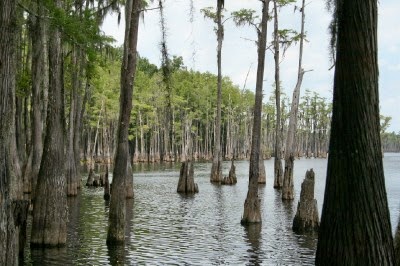 |
| The Money Pond in Jackson County, Florida |
The lost treasure of the Money Pond is #95 on our list of 100 Great Things about Jackson County, Florida.
Click here to see previous items on the list.
In the northeast corner of Jackson County, legend holds that a pirate treasure waits to be found deep beneath the mud and muck of a swampy body of water. Locals call the place the "Money Pond" and many believe there is enough gold and silver at its bottom to make the person who finds it an instant millionaire.
 |
Spanish treasure on display
Museum of Florida History in Tallahassee |
That is likely even more true today thanks to the astronomical price of gold, which at the close of the markets today was selling for $1,339.50 per ounce. Silver closed at $20.89 per once. Legend holds that the pond contains 7 horse loads of gold and silver, each said to weigh over 100 pounds.
If true, that means there is somewhere around 11,200 ounces of gold and silver at the bottom of the Money Pond. If half of it is in gold, then the value for the weight of the metal alone would be nearly $8 million!
 |
| More Spanish Treasure at the Museum of Florida History |
And that's just the beginning of the story. The actual value of the treasure could be much, much higher because each of the coins would be worth far more to collectors than the value of its weight alone. A much smaller hoard of three cans containing gold coins from the 19th century was recently found in California and is already thought to be worth more than $10 million.
So is the story true? Is an unbelievable treasure waiting to be found at the bottom of a swampy Florida pond?
The answer to those questions may be... yes.
 |
William Augustus Bowles
Self Portrait of the Pirate "Billy Bowlegs" |
The story has its roots in the real life of the famed pirate and adventurer, William Augustus Bowles. He is celebrated in Fort Walton Beach today as the Pirate Billy Bowlegs, which often causes him to be confused with the later Seminole Indian chiefs of the same name.
Born in Maryland in around 1763, Bowles joined the British military service in 1776 when he was thirteen years old. That was the year, of course, that the United States declared its independence from Great Britain. Bowles was from a family of Tories, however, and his loyalty was to King George III.
According to an early
History of the Bowles Family, he fought at the Battle of Monmouth, New Jersey, before traveling with his regiment from New York to Jamaica and from there to Pensacola. Spain had lost Florida to Great Britain at the end of the French & Indian War and it is a little known fact that East and West Florida remained loyal British colonies during the American Revolution.
According to family historian Thomas M. Farquhar, Bowles was driven from the British service following a dispute with one of his commanding officers. The exact details remain murky and there are several different versions of what happened.
 |
| Lower Creek village in Jackson County, Florida |
Only 15 years old at the time, he decided to walk home to Maryland and set off on his own through the vast wilderness of the Florida Panhandle. He quickly became completely lost, but was discovered by a party of Lower Creek Indians from the Perryman towns. These villages, located in today's Jackson County, Florida and neighboring Seminole County, Georgia, were headed by Thomas and William Perryman. The son and grandson of English trader Theophilus Perryman and his Creek wife, the two Perryman chiefs were wealthy mestizos (a term meaning they were of mixed Creek and European ancestry).
Since the Creeks were on good terms with the English, the warriors carried Bowles to their towns and he quickly ingratiated himself with the Perryman family. He later married Thomas Perryman's oldest daughter and led the Perryman warriors during the Battle of Pensacola in 1780.
 |
| Flag flown by William Augustus Bowles |
In 1791, at the age of 22, he traveled to London where he negotiated docking rights at British ports in the West Indies for ships flying the flag of what he called the "Creek and Cherokee Nation." These rights in hand, he traveled to New Providence in the Bahamas where he purchased a small sloop and began trading voyages back and forth to the Lower Creek towns on the Chattahoochee River.
On a more ominous note, however, he armed his vessel with cannon and soon entered the life of a pirate, capturing merchant ships on the Gulf of Mexico. He was very good at being a pirate and his one ship soon turned into a flotilla of pirate vessels.
To give these ships at least a semblance of legitimacy, he declared the independence of what he called the "State of Muskogee" and declared war on Spain. Florida had returned to Spanish control at the end of the American Revolution, but the British trading firm of Panton, Leslie and Company had remained behind. Turning his flotilla of pirate ships into the "Muskogee Navy," Bowles became a major thorn in their side.
He and his pirate crews, which included white, black and Creek Indian men, raided merchant vessels traveling in the Gulf. On one occasion they defeated Spanish coast guard vessels in a fierce battle on Apalachicola Bay. Among the vessels of his fleet were the warships
Mackisuky and
Tostonoke.
 |
Ekanachatte in 1778
From the Purcell-Stuart Map |
In one of his letters, Bowles mentioned plans to bring a ship loaded with cargo up the Apalachicola River to either the trading post of James Burges (Burgess) at what is now Bainbridge, Georgia, or a place he called "The Bully's" on the Chattahoochee River.
The Bully, so named for his prowess as a trader, was the chief of the Lower Creek town of Ekanachatte ("Red Ground") which lay on the west bank of the river at what is now Neal's Landing Park in Jackson County. He was a supporter and business associate of Bowles and was fabulously wealthy for his time.
Bowles became such a threat to Spanish and merchant shipping that a reward of $6,000 (in 1790s currency) and 1,500 kegs of rum were offered for his capture. He eventually was captured and died while on a hunger strike at the fort of El Morro in Cuba.
 |
| Chattahoochee River at Neal's Landing (Ekanachatte) |
According to legend, however, his treasure remained behind at Ekanachatte (Neal's Landing). It stayed safe there until 1818 when, during the First Seminole War, the Creek troops of Brigadier General William McIntosh drove south into Florida as part of Andrew Jackson's invasion. Fearful that the treasure would be captured, the chief and warriors of the town sank it into the Money Pond.
McIntosh defeated the Ekanachatte warriors at the Battle of the Upper Chipola near Bellamy Bridge in March 1818 and the treasure was forever lost.
See Battle of the Upper Chipola.
 |
| The Money Pond |
The story, however, does not end there. During the early 1900s, two major expeditions were launched by treasure hunters to find the lost gold and silver of William Augustus Bowles. The largest of these arrived in northeastern Jackson County in 1927, dug a ditch and drained the Money Pond. Once the mud had dried somewhat, they started digging... and found Spanish silver coins in the muck at the bottom of the pond!
Before they could recover the main treasure, however, it began to rain. 1927 is remembered today as the year of the Great Flood. From Louisiana east and the Ohio River south, flood waters rose to unheard of levels. In Jackson County, the Chattahoochee surged from its banks and flowed as far inland as Malone. The treasure dig came to an end as raging flood waters flowed through the swamps and forced the men to flee for their lives. They never came back.
The treasure, it is said, is still there today.
To read more of the story of William Augustus Bowles and the Money Pond, please consider my book,
The History of Jackson County, Florida: The Early Years. It is available at Chipola River Book & Tea in downtown Marianna or online from Amazon.com by clicking here:
(Kindle)The History Of Jackson County, Florida: The Early Years
.
The Kindle version is available for instant download by clicking here:
The History of Jackson County, Florida: The Early Years
.
Ekanachatte, near the legendary Money Pond, is one of the stops on the new Jackson County Spanish Heritage Trail. The 150 mile driving tour passes 11 key Spanish colonial sites in Jackson County. The new guide booklet is available at the historic Russ House and Visitor Center in Marianna. Learn more online at
http://visitjacksoncountyfla.com/heritage/spanish-heritage-trail/.



.jpg)












































